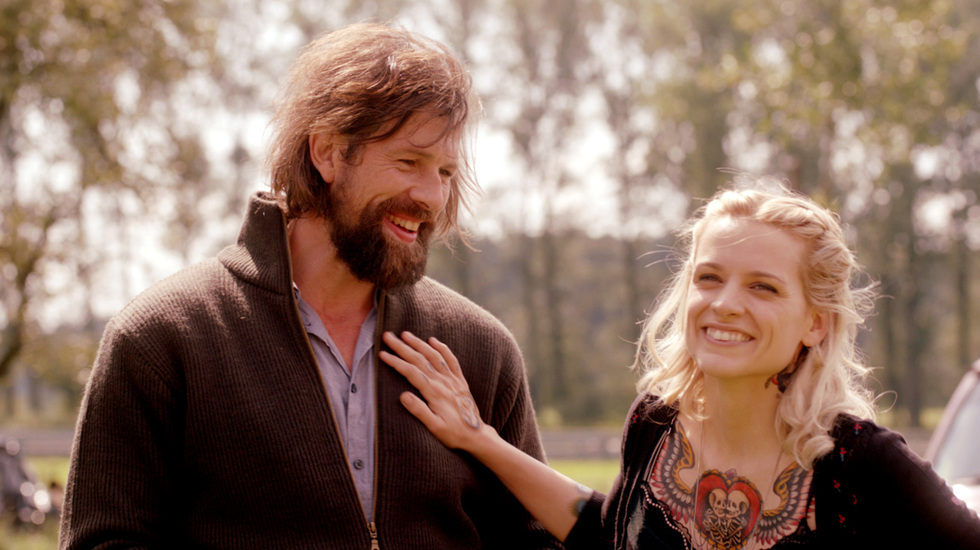The Broken Circle Breakdown – Film Review
Reviewed by Damien Straker on May 14th, 2014
eOne presents a film by Felix van Groeningen
Written by Felix van Groeningen and Carl Joos, based on the play “The Broken Circle Breakdown Featuring the Cover-Ups of Alabama” by Johan Heldenbergh and Mieke Dobbels
Producers: Arnold Heslenfeld, Dirk Impens, Laurette Schillings, Frans van Gestel and Rudy Verzyck
Starring: Johan Heldenbergh, Veerle Baetens and Nell Cattrysse
Music by Bjorn Eriksson
Cinematography: Ruben Impens
Editing: Nico Leunen
Running Time: 111 minutes
Rating: MA15+
Release Date: May 15th, 2014
The Belgian feature The Broken Circle Breakdown has a booming political voice and a pair of committed performances but as a film it does not work. It is apparent that the narrative was moulded heavily for the screen but without fully embracing and adapting to the filmic medium. The story is about a couple named Didier (Johan Heldenbergh) and Elise (Veerle Baetens). They have been a couple for seven years and sing together in a bluegrass band. Didier wants to live like a cowboy because he loves American country music and Elise, while covered in her own tattoos that detail her previous relationships, is running a tattoo parlour. The couple is told their five year old daughter Maybelle (Nell Cattrysse) has been diagnosed with cancer. Using a non-linear structure, the director Felix van Groeningen cuts between this present day crisis and then back to when the couple first met. He also flashes forward to a pivotal future moment when Elise herself is being rushed to hospital. The shape of the narrative is a stylistic choice rather than a psychological one because the time shifts do not enrich the depth or meaning of the lives of the characters. The lead work by Johan Heldenbergh (Didier) and Veerle Baetens (Elise) is adequate and the music is cheerful but in spite of the bleak premise the film isn’t an emotional force.
The fate of a child and the subsequent breakdown of the family unit isn’t a new idea either because there have been an immeasurable number of films depicting this tragedy. Lars von Trier’s Antichrist (2009) is one of the recent and grimmer examples. For Groeningen the adaptation process is a far greater problem than originality. The script he and Carl Joos have written is from the play “The Broken Circle Breakdown Featuring Cover-Ups of Alabama”, by Heldenbergh himself and Mieke Dobbels. One of the difficulties with translating a play to a film is the contrasting forms of the two mediums. A play is almost entirely dialogue driven, while cinema is largely a visual medium, relying heavily on images to tell a story. The play apparently featured a number of monologues that Groeningen admits would not have been cinematic if they were included in the film. Consequently, some of the characterisation has been lost and the two characters seem rather flimsy. Groeningen has also said that he has not plotted the film through story but emotion, which accounts for why it isn’t very eventful till late in the piece and why it lacks a strong through-line. Similarly, Maybelle’s sickness forces the two adult characters to be reactionary and express themselves largely from their emotions and dialogue, like a play, rather than providing them with something to act upon. The music performances are injected to redeem this problem and to provide more “action”. They are a pleasant diversion, even though the instruments are sometimes too loud for the singing voices.
The bumps in the script must have been visible to Groeningen because he tries hiding them within the non-linear storytelling. He admitted that the structure was developed in the film’s editing process. For a little while the dual timelines dissolve the story’s dramatic simplicity. A slick overlap between the timelines contrasts Didier and Elise building a home for their child and then cuts to the present as they bring Maybelle back to the finished property from the hospital. However, the structure is largely window-dressing, covering for what is mostly a simple melodrama with loud political ideas. Didier and Elise exist to verbalise an ideological and social debate. When tragedy strikes, Didier blames the Bush administration for fighting against stem cell research, while Elise is driven by her faith and the possibility of spiritual healing. The director offers no subtlety in expressing Didier’s atheist viewpoint. He zooms in on footage of George W. Bush speaking on television and allows Didier to yell at an audience, in monologue style, about the failures of the US government and religious conformity. The play originally came out in 2008, just a year after the Bush administration was replaced. The scientific debate would have been timelier several years ago. Once the tragedy unfolds and the flashy narrative structure is pared back, the film’s verbal friction takes over and the parents blame each other for the grief in their lives. But everything is pitched at such an overly melodramatic level that I found myself resisting the film rather than being moved by it.
Summary: In spite of the bleak premise the film isn't an emotional force









